Ancient coins with short stories. Every ancient coin is interesting. Some have stories that are best told as part of a series. However, this page is devoted to coins that are interesting all by themselves. Although, in any story context is important and will be discussed here.
What's new? 2022, June 25: The bridge at Antioch on the Maeander river. A portrait of Pompey.
Table of Contents:
Mausoleum. The origin of the term for a large and impressive tomb. (New, 2022, Feb. 14.)
Tarentum (Taras) during the Pyrrhic War:
A Roman Provinical coin that explicitly names its denomination, a didrachm.
A large provincial coin.
AVGVSTA IN PACE, a reverse legend unique to Salonina
Leo VI, Byzantine emperor
A tiny coin of Cyzicus provokes thoughts on how condition and rarity affect price.
A "common" type that is rare. How can that be?
A "mule." The two sides do not belong on the same coin.
 The bridge at Antioch on the Maeander river. Antioch on the Maeander river in Caria was a minor town (The location is marked in red on the map). The river is famous for lending its name to the word meander, meaning "with a winding course." Little is known about the town except it had a bridge which is no longer extant.
The bridge at Antioch on the Maeander river. Antioch on the Maeander river in Caria was a minor town (The location is marked in red on the map). The river is famous for lending its name to the word meander, meaning "with a winding course." Little is known about the town except it had a bridge which is no longer extant.
But, the city did strike a few impressive Roman provincial coins. This one is larger than a Roman sestertius at 36 mm and 24.03 grams.

Gallienus (253-268), sole reign, 260-268.
Helmeted bust left, holding spear forward and shield.
Bridge with 6 arches, rivers flowing below, river god reclining on it with reed and cornucopia, and three-arch arch (with a bird on top) at the left end. Similar coins come as small as 31 mm. Obviously, the larger 36 mm version is more impressive.
Sear Greek Imperial 4568.
SNG von Aulock II 2430 and IV 8059 variety (with the arch on the right instead of the left).
Price and Trell, page 50, figure 82 (reverse only).
A second feature of interest is the helmeted bust of the emperor. In the late third century and fourth centuries emperors are often depicted helmeted on coins. However, I don't know of imperial or provincial coins which have the emperor helmeted earlier than than Gallienus.
Pompey the Great on a Roman provincial coin. Pompey (d. 48 BC) conquered much of the east for the Romans in the 60s BC and renamed the Cilician city Soli after himself--"Pompeiopolis." He did not mint portrait coins in his own name (no Roman did in those days), but his son Sextus Pompey (d. 35 BC) did while fighting against Julius Caesar. Portrait denarii of Pompey are expensive. The city Pompeiopolis did not mint many coins in the imperial period, but under Domitian it did mint some coins with a portrait of Pompey.
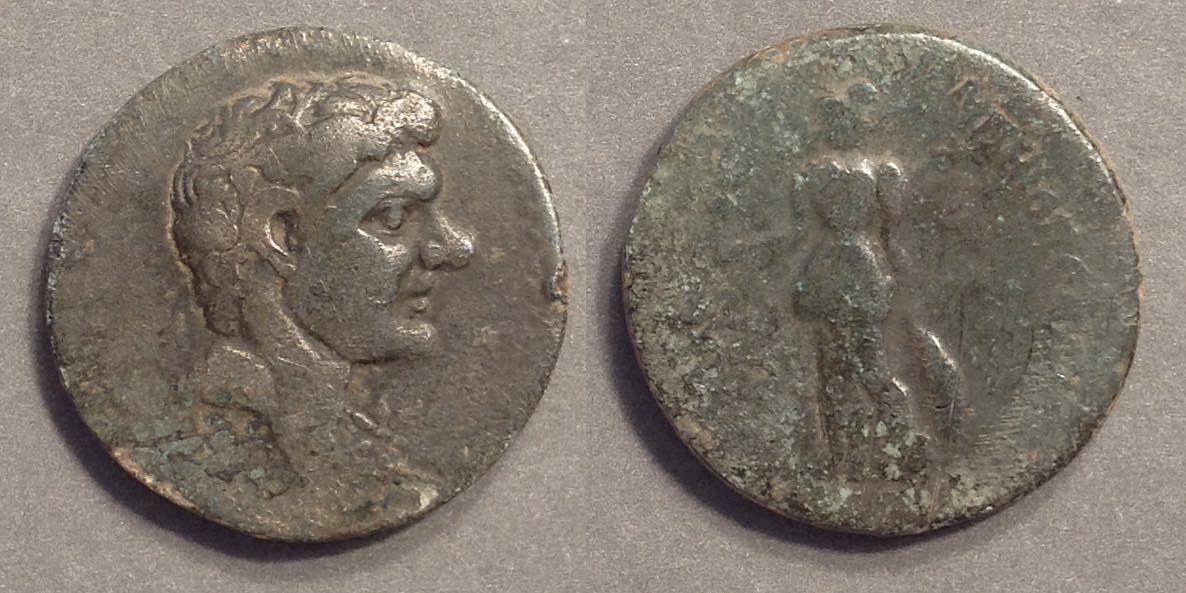 Pompey right, with his distinctive nose.
Pompey right, with his distinctive nose.
23 mm. 8.90 grams.
Athena standing left holding out Nike and resting left on shield.
Struck 83/4 AD--it is dated explicitly on the reverse--under Domitian.
RPC II online 1725
SNG France 2 (Cilicia) 1223 (same dies)
SNG Levante (Cilicia) 878
Mausoleum. The origin of the term for a large and impressive tomb.
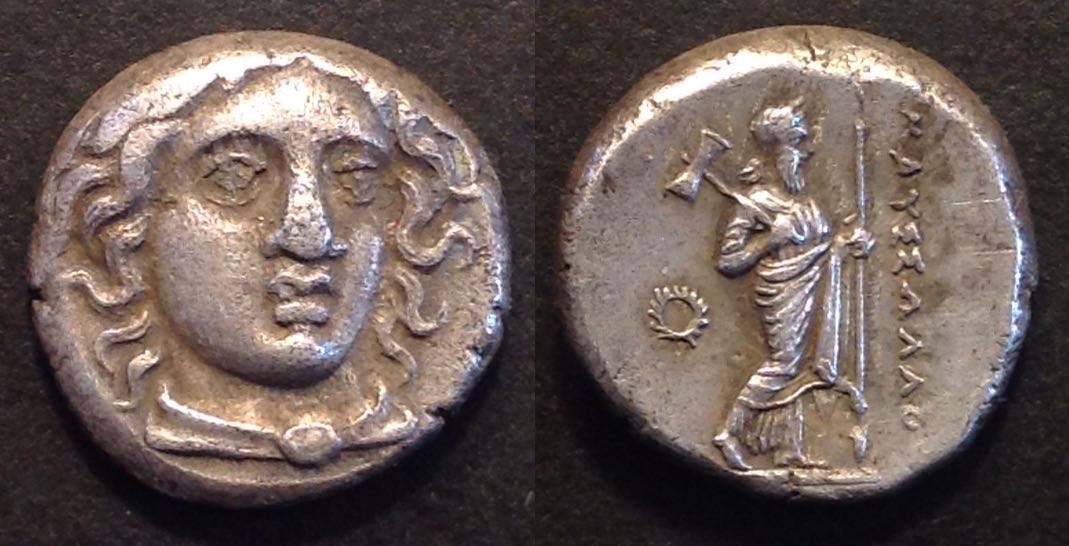 Drachm. 14 mm. 3.70 grams.
Drachm. 14 mm. 3.70 grams.
Persian Satrap of Caria, Mausolos, 373-353 BC.
Apollo 3/4 facing right. Zeus Labraundos standing right with labrys (double ax) and spear, wreath in left field.
Sear Greek II 4956. SNG Danish V Caria 591-593. SNG von Aulock 2361-2365. SNG Finland Keckman I 276. SNG Turkey I Kayhan 874-879.
Minted at Halikarnassos, Caria, now Bodrum on the southwestern coast of modern Turkey.
(This coin is a drachm. There are tetradrachms of the same design.)
We spell his name "Mausolos," but he spelled it with a double S and double L: MAYΣΣΩΛΛO
Take a look at the legend:
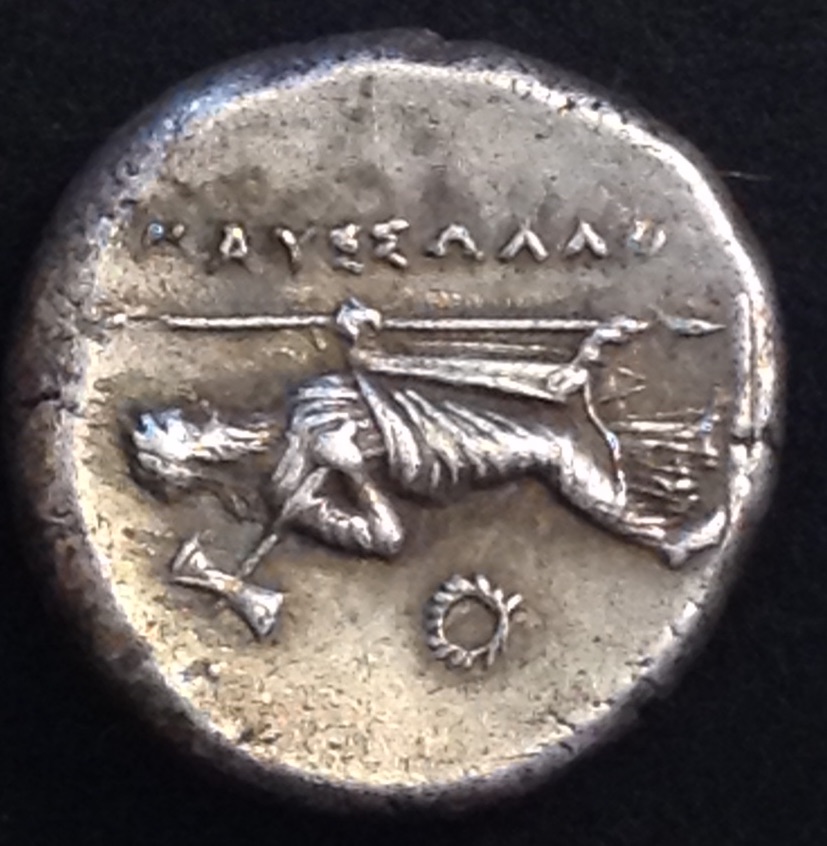
From Wikipedia under "Mausoleum": "The word derives from the Mausoleum at Halicarnassus (near modern-day Bodrum in Turkey), the grave of King Mausolus, the Persian satrap of Caria, whose large tomb was one of the Seven Wonders of the Ancient World."
The tomb was a massive structure 145 feet high, possibly still extant in the 12th century but in ruins by the 15th and since then the building materials have been recycled and reliefs removed, so there is very little remaining. The wikipedia article shows the site and pictures of many of the extant sculptural elements now in various museums.
Tarentum (Taras) during the Pyrrhic War. The boy-riding-dolphin type of Taras (= Tarentum, on the inside of the heel of Italy's boot) is very well known and comes with many varieties. This one, with an elephant, is more connected to history than most.
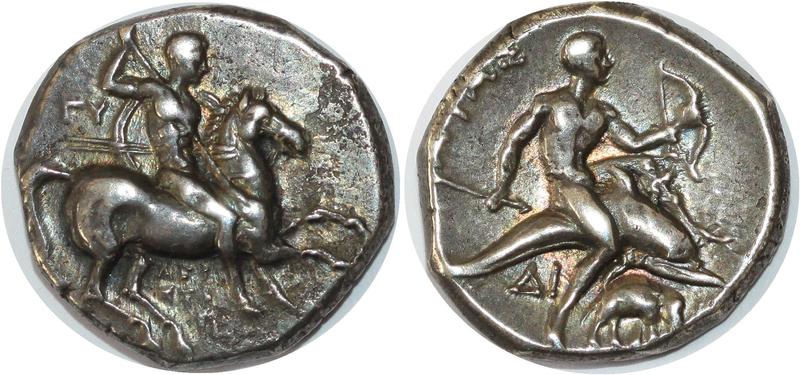 20-19 mm. 6.52 grams, of "Tarentine standard".
20-19 mm. 6.52 grams, of "Tarentine standard".
Struck 280-272 BC.
Horseman right, spearing downwards, shield and two extra spears
Dolphin rider right with bow and arrow, elephant below, TAPAΣ almost off the flan at 10:00-11:00.
Hoover Handbook I (Magna Graecia) 881, Sear Greek -- but close to 370, HN 999, Côte 363-5. SNG Cop 873.
This reverse has a connection to history. Pyrrhus, King of Epirus was invited to lead the Tarentines in their war against Rome, which we now know as the Pyrrhic War, 280-275 BC. He was the first to use war elephants in Italy, hence the elephant on the reverse. Pyrrhus famously won two battles but suffered crippling losses and is quoted as saying "If we are victorious in one more battle with the Romans, we shall be utterly ruined."
Many boy-riding-dolphin coins weigh distinctly more, c. 7.8 grams instead of c. 6.5 grams, but this one is on the reduced standard of coins minted during the war.
A didrachm that names its denomination. US cents say "ONE CENT" but ancient coins very rarely name their denomination. Some ancient coins indicate their denominations. For example, early Republican denarii have an "X" for ten, but that is not quite the same as actually naming the denomination. Many aureliani from Aurelian's coin reform of 274 have "XXI" which apparently gives the silver content (20 parts copper to 1 of silver). Those examples indicate the denomination, but are not as explicit as the next one minted under Claudius in the name of Nero.
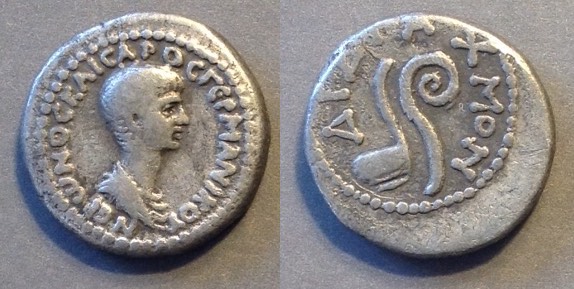
Thick. 19 mm. 6.86 grams.
The reverse says "ΔIΔPAXMON" = didrachm
around simpulum and lituus.
NEPωNOC KAICAPOC ΓEPMANIKOY
(Nero Caesar Germanicus)
bare-headed, draped, bust of young Nero right
Struck 50-54 under Claudius at Antioch, Syria
RPC I 4171 (16 pieces from 2 obverse dies)
McAlee Antioch 272, Prier 70.
This type was formerly attributed to Ephesus (BMC Ephesus 209, Copenhagen Ephesus 375).
A Large Provincial. Sestertii are big, but some provincials are bigger. Most sestertii of the late second century are c. 30-31 mm and this provincial coin is 40-38 mm. Because pictures can't indicate size without some standard of comparison, I included a denarius to give a sense of scale:
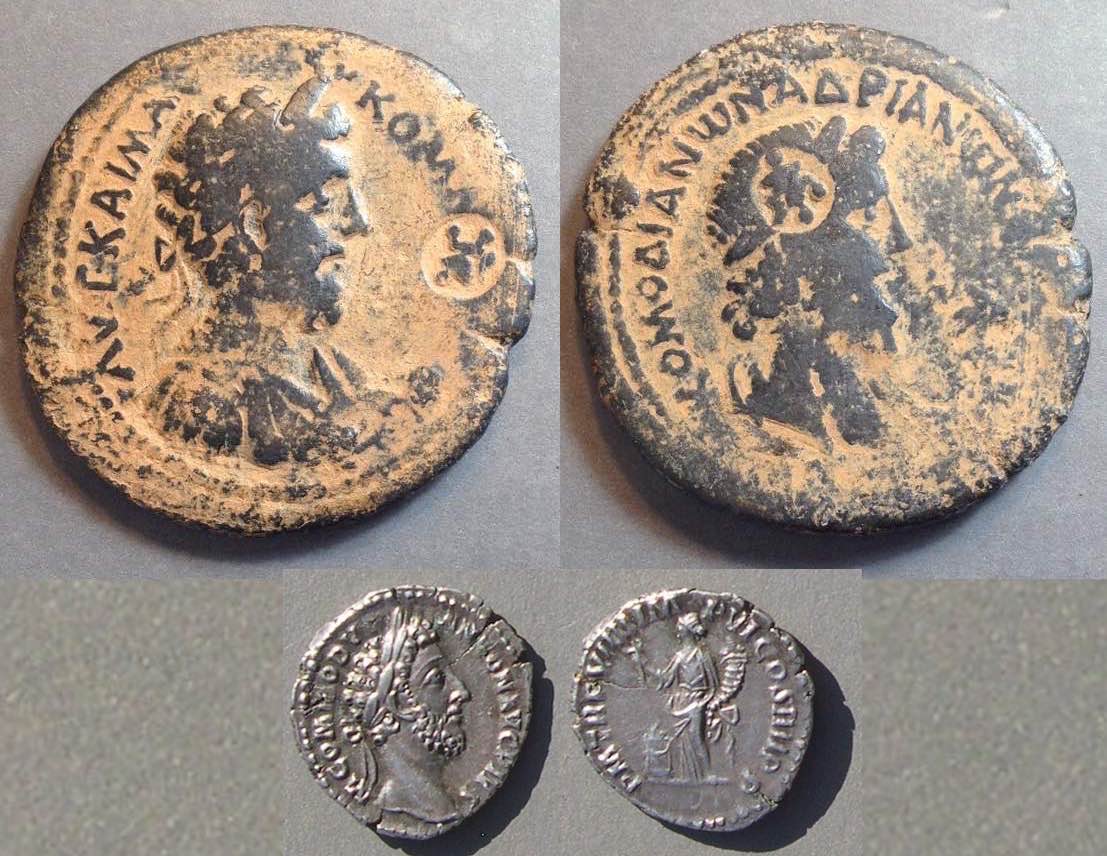
This big coin is 40-38 mm and 27.36 grams from Aegeae in Cilicia.
AVT KAI M AV KOMMOΔOC AN
Bust of Commodus right, laureate, draped, and cuirassed. Countermark of Victory on globe at 3:00 (Howgego 258)
KOMOΔIANWN AΔPIAWN AIΓEAIWN ΔΛC
Diademed and draped bust of Asklepios right, same c/m on head.
Struck CY 234 = 187/8 CE.
RPC IV.3 online 9745, one piece, but Leu thought there were four.
The smaller one is a denarius, 18 mm.
Struck 183/4.
RIC 74.
Very large provincials are sometimes called "medallions." I don't think they are like imperial "medallions" which are not normal circulating currency. I think the very large provincials were usually just large denominations for cities that did not mint silver coins.
Lanz auction catalog 92 (June 1999) was a very unusual sale catalog--it included over 90 provincials c. 36 mm or larger.
Antonia. Some imperial women are hard to obtain on "imperial" coins, but more available on coins of Alexandria, Roman Egypt.
This tetradrachm of Roman Alexandria has emperor Claudius on the obverse and Antonia, his mother, on the reverse. Antonia was the younger daughter of Mark Antony and Octavia and named with Antony's name in the feminine form, as was the rule for naming girls in Rome.
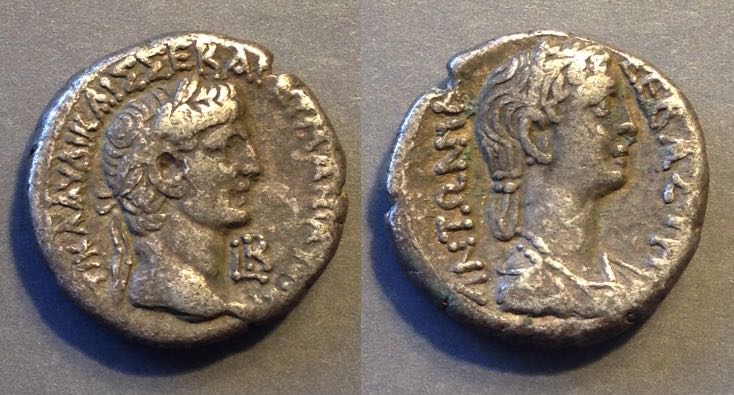
Tetradrachm. 24-23 mm. 12.43 grams.
Struck year 2 [LB] = 41/2 CE.
TI KΛAVΔI KAIΣ ΣEΒA ΓEPMANI ΑΥΤΟK
(Tiberius Claudius Caesar Augustus Germanicus Autocrater)
ANTΩNIA ΣEBAΣTH
(Antonia Augusta)
Emmett 73, common for year 2 like this one, extremely rare for years 1 and 3.
RPC I 5117 notes 34 pieces.
Forschner 48-55 (8 pieces). Geissen 62-64 (3 pieces). [These 11 published pieces were presumably among the 34 noted in RPC.]
This coin has a reverse legend unique to Salonina, wife of Gallienus (253-268).
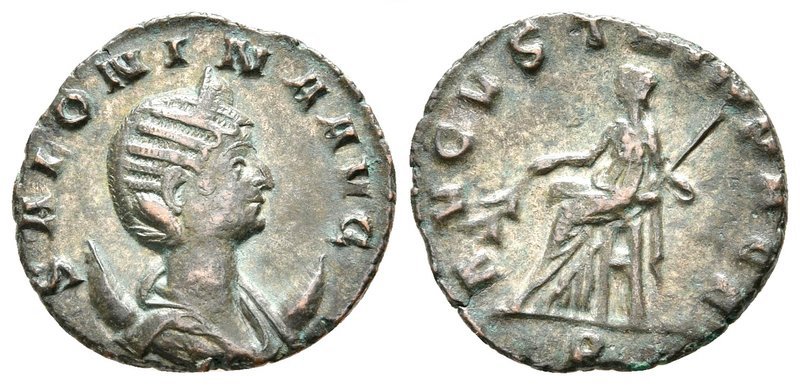
21-20 mm. 2.74 grams.
SALONINA AVG
Bust of Salonina right on crescent.
AVGVSTA IN PACE, Salonina as Pax, seated left, holing olive branch and transverse scepter, P in exergue.
The obverse is well struck. The reverse is crowded and weaker, but legible. Few coins of Salonina are well-struck from unworn dies on both sides.
The reverse legend can be interpreted as having a Christian reference and long ago was sometimes interpreted as alluding to Christian leanings of Gallienus. However, other evidence for such leanings is lacking and modern scholars now seem to reject any Christian reference, without, as far as I know, being able to explain why this legend appeared at this time.
It also appears with this abbreviated spelling:
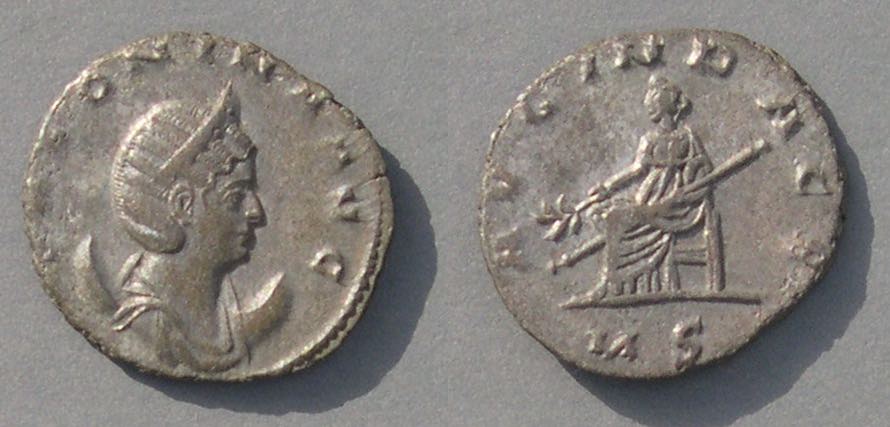 21 mm. 3.79 grams.
21 mm. 3.79 grams.
AVG IN PACE
MS in exergue.
RIC Salonina 58.
On CoinTalk, Sulla80 added this
Here's more information on the type from Blois, Lukas . The Policy of the Emperor Gallienus. Leiden: Brill, 1976.
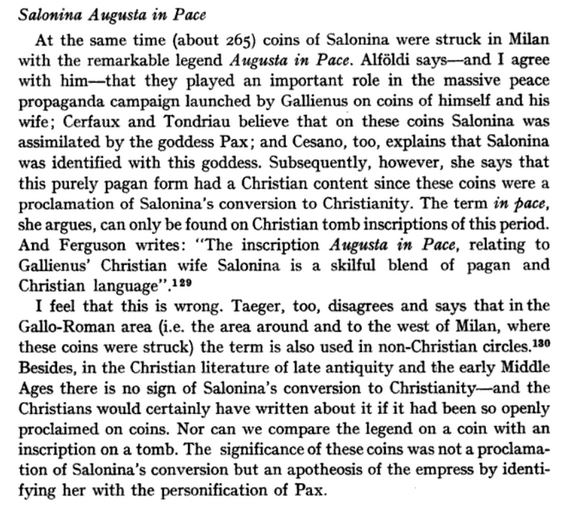
Leo VI, the Wise. Leo VI was the elder son of Byzantine emperor Basil I and assumed the throne in 886 when Basil died. Alexander was the younger son. He was not so "wise" in the modern sense, rather "scholarly" and somewhat detached from the business of government. Is this type before or after the very common Leo-alone type?
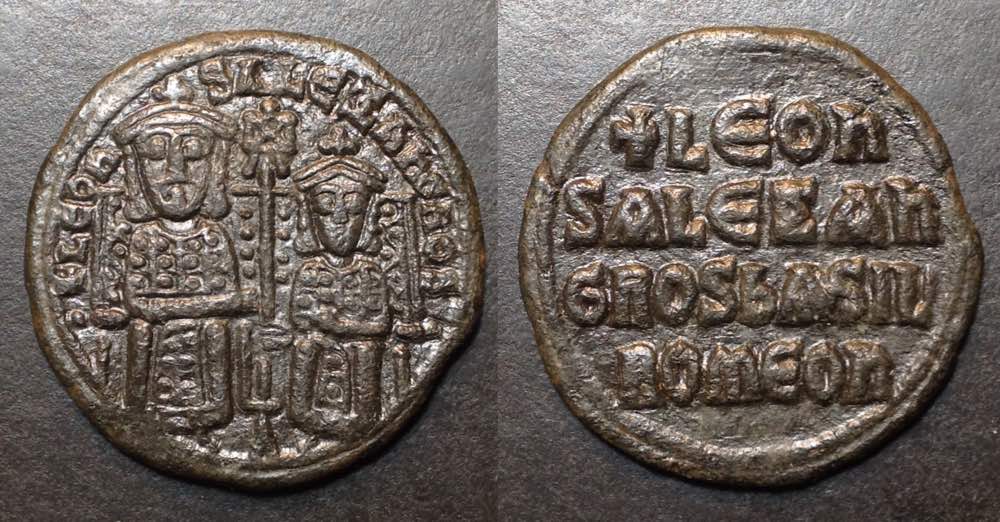 27 mm. 8.46 grams.
27 mm. 8.46 grams.
Leo VI and Alexander, 886-912
+LЄOҺ-S AΛЄΞAҺGROS, Leo VI on left, smaller Alexander on right, both crowned and wearing loros, labarum between [The letter that looks like a G may be a version of Δ]
4-line legend
+LЄOҺ /SALЄΞAҺ/GROS BASIL/ROMЄON
Grierson wrote the Dumbarton Oaks volume 3.2 which covers this reign. He notes there is uncertainty if this type is early in the reign or later. Usually we determine relative chronology with hoards. Hoards deposited part way through the reign with one type and not the other would be used to establish that the missing type was later. But when Grierson wrote DOC such hoards had not been found to determine whether the very common Leo-VI-alone type is earlier or later. It can be argued that this joint type was first because Alexander was included initially by the wishes of Basil and it took time for Leo to gather enough power to push Alexander aside. On the other hand, it can be argued that this type followed the Leo-alone type because Leo had great difficulty fathering a male heir and he may have begun coinage alone and reluctantly conceded he might need to let his brother succeed him (which, in fact, happened).
Eventually Leo VI had a son by this fourth wife (having three marriages was forbidden by the Church and having four marriages was major scandal). When Leo died his son was too young, so Alexander was made emperor, but in his year-long reign he did not issue base-metal coinage except for very rare coins from the Cherson mint. When Alexander died the young son Constantine VII of Leo was promoted with his mother as regent and that began a long story of his coinage, part of which is told here:
http://augustuscoins.com/ed/Byz/ConVII.html
It was also told in a similar CoinTalk thread:
https://www.cointalk.com/threads/constantine-vii-replaces-romanus-i-byzantine.337736/
Greek Silver Fractions. Some of the most common Greek silver coins of fractional denominations are from Kyzikos (Cyzicus) with the forepart of boar with tunny behind / lion's head like this one:
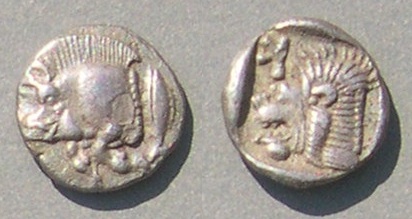 It comes in various weights and small denominations. This one is 9 mm and 0.82 grams, probably an obol. There are also hemi-obols and even smaller denominations with the same basic design. There are 59 with designs very much like this one on vcoins as I write. The type is common.
It comes in various weights and small denominations. This one is 9 mm and 0.82 grams, probably an obol. There are also hemi-obols and even smaller denominations with the same basic design. There are 59 with designs very much like this one on vcoins as I write. The type is common.
Sear Greek 3848. Klein 264. BMC Mysia Cycicus 121.
Now the next coin from Kyzicos is earlier and different in significant ways.
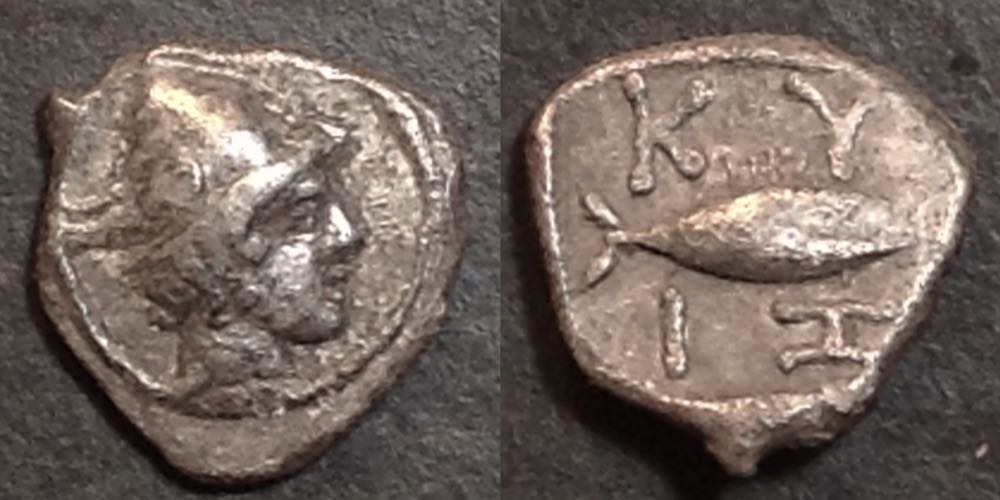 7 mm. 0.25 grams. (That is very small. Compare it to a US cent, below)
7 mm. 0.25 grams. (That is very small. Compare it to a US cent, below)
Head of Hemes right wearing winged petasos
KY IZ (Z shaped differently than my fonts allow) around tunny right
The attribution to Kyzikos is obvious, both from the lettering and the tunny. But, the attribution would not be so obvious from checking the major catalogs.
SNG Copenhagen -- Supplement --, BMC Mysia --, SNG France Mysie --
Sear Greek --, Klein --, Rosen --, Boston --, Dewing --, SNG Turkey I Kayhan --
and SNG von Aulock 7338 (It's in there!)
So, given only pre-internet-style sources, it would be called very (or even "extremely") rare.
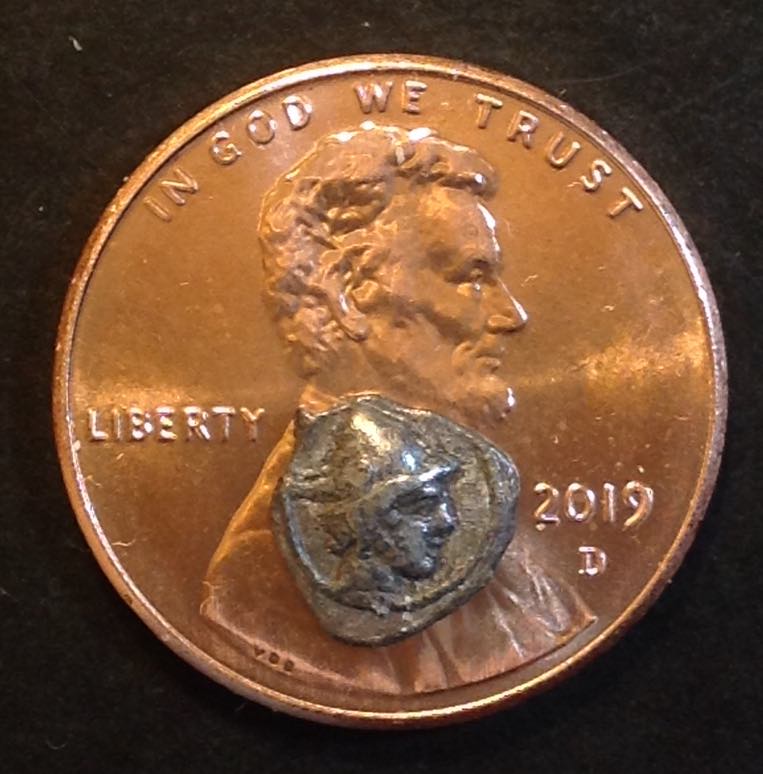 However, now we do searches with modern on-line databases which have digital images, mostly from auctions since about 2000. acsearch has no examples offered prior to 2011, so it was rare enough to not appear in their auctions for a decade. In 2011 at least two bidders thought it was very rare:
However, now we do searches with modern on-line databases which have digital images, mostly from auctions since about 2000. acsearch has no examples offered prior to 2011, so it was rare enough to not appear in their auctions for a decade. In 2011 at least two bidders thought it was very rare:
https://www.acsearch.info/search.ht...s=1&thesaurus=1&order=0¤cy=usd&company=
That example, which is not better, hammered at $1300! (That same coin and price-realized is listed twice because it the auction conducted jointly by two firms and it is under each of the firms names). It looks like since then maybe a dozen have appeared (several listed twice on acsearch), most closer to $100 as the hammer price. So, I think the "very rare" label is no longer applicable. However, there are none on vcoins or MA-Shops and I am still calling it "rare." But, auction records no longer price it as something highly desirable. Why is that?
I think that rarity boosts price when collectors "need" a type to complete a set, but this type does not fit any commonly collected set. (I once wrote an article on rarity and its impact on cost. It is on the web here.) Also, experienced collectors realize that many thousands of types are "rare" and they can't afford to care about rarity as much as the other possible reasons for desiring a coin (It's old, it's beautiful, it's historical, it's big, it's gold, etc.). This type might be desirable because "It's small" but that is not going to add much, if anything, to its price:
I think that both condition and rarity are important for price, but that condition is, relative to the previous century, relatively more important and rarity less so. There are just too many rarities to care about them unless they fit some limited list (like the list by Ras Suarez of frequencies of Romans on imperial coins).
Sometimes, paradoxically, RIC lists a coin as "common" yet the type is actually rare (even though RIC didn't make a mistake). Here is how that can happen, discussed in the context of RIC VI which covers the reform of Diocletian through the second tetrarchy, that is 294-313.
This paradox is not the same as "rare" coins that are actually common. Usually a late Roman copper type comes in many minor varieties. So, the frequency of the type sums the frequencies of many varieties. Fifty varieties, some individually rare, might add up to one common type. Many sellers can mislead potential buyers by quoting the RIC rarity of a particular variety (which is of almost no interest to anyone) as rare although the type as a whole is common.
This is the reverse, the variety is "common" but the type is "rare."
 Constantius I. Augustus of the second tetrarchy, 305-306.
Constantius I. Augustus of the second tetrarchy, 305-306.
29-27 mm. 8.74 grams.
FIDES MILITVM AVGG ET CAESS NN, Fides seated left, holding standard in each hand
AQS in exergue
RIC VI Aquileia 62, page 320. "C"
RIC says this is "common," so how can it be rare?
Here is how. Pay attention to the distinction between "types" and "varieties."
A particular variety is, by RIC's definition, "common" by being in every major national collection. This does not necessarily imply very many of that exact variety are known. And, if a type is issued at only one mint for a short period of time and quite rare with only one or two varieties, it is possible that the type is rare yet major museums all have one of that variety (after all, the collectors who donated their coins to the museums sought unusual types). So, the variety can be "common," but there are so few varieties that the type is rare.
According to RIC VI, the precise Constantius variety above is in the major museums. But the legend was issued only at Aquileia (not a dozen mints like most follis types of the period). Furthermore, the legend is more often accompanied by Fides standing, whereas this one is seated. Failmezger's excellent book Roman Bronze Coins: From Paganism to Christianity, 294-364 A.D. lists all the coins by type (not by variety). His Type 44 has the legend and Fides standing. This type with Fides seated is not noted, by accident. RIC VI has 727 pages and you can imagine how easy it would be to overlook the distinction between "stg." and "seated" on a rare type listed at only one mint. This type is rare, although glancing at its number in RIC would show "Common". By the way, there are no coins of this type (for any emperor) on vcoins or MA-Shops as I write. The coin above is not in great condition, but it would be difficult to find a better one, or even one at all!
A Mule. Mules (a.k.a. hybrids) are coins that combine an obverse type and reverse type that were not intended to be issued together. This one has an obverse of Constantine II and a reverse of Constantine.
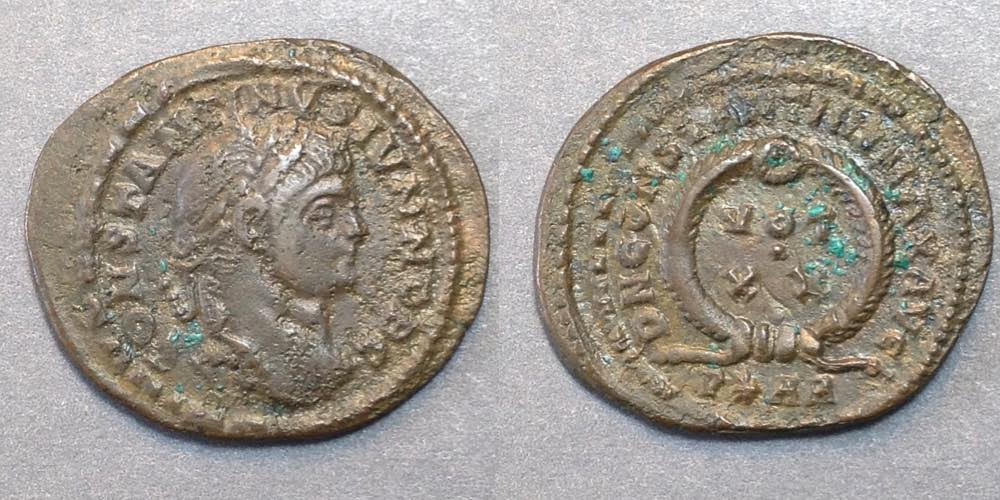 22-20 mm. 3.03 grams.
22-20 mm. 3.03 grams.
The obverse of this type is for Constantine II
CONSTANTINVS IVN NOB C
The correct reverse for Constantine II is "VOT/X" reverse in a laurel wreath with CAESARVM NOSTRORVM around. This erroneous reverse is visually quite similar and belongs to Constantine with "VOT/XX" in the wreath and DN CONSTANTINI MAX AVG around. The two types were issued at the same mint at the same time. Apparently the reverse die was used at the wrong officina. Normally, P and S were the officinae for Constantine, and T and Q were for Crispus and Constantine II. So, this coin is a mint mistake of the sort called a hybrid or mule.
RIC Arles 255/252-3, page 261. "322-3"
Lars Ramskold, a specialist in coins of the era of Constantine, notes coin is from an issue of Arles which has numerous overstrikes and some mules. Notice the double rim on the left side of the reverse which shows it was overstruck. Lars says "most overstrikes are on Licinius' eastern IOVI CONSERVATORI issues, coins that were not recognized by Constantine." The issue is shared between Constantine as Augustus and Crispus and Constantine II as Caesars. It is distinguished by the mintmark P✳AR (the place of P can be held by S, T, or Q) and dated by RIC to 322-3.
By the way, there are many mules among imitations from the second and early third centuries. Counterfeiters attempted to make low-silver coins that could pass for official coins, but they had no incentive to match the obverse and reverse types in the official manner. If you see a mule from that time period, the odds are good it is an ancient imitation.
Go to the Table of Contents of this whole educatonal site.
 The bridge at Antioch on the Maeander river. Antioch on the Maeander river in Caria was a minor town (The location is marked in red on the map). The river is famous for lending its name to the word meander, meaning "with a winding course." Little is known about the town except it had a bridge which is no longer extant.
The bridge at Antioch on the Maeander river. Antioch on the Maeander river in Caria was a minor town (The location is marked in red on the map). The river is famous for lending its name to the word meander, meaning "with a winding course." Little is known about the town except it had a bridge which is no longer extant.
 Pompey right, with his distinctive nose.
Pompey right, with his distinctive nose. Drachm. 14 mm. 3.70 grams.
Drachm. 14 mm. 3.70 grams.
 20-19 mm. 6.52 grams, of "Tarentine standard".
20-19 mm. 6.52 grams, of "Tarentine standard".



 21 mm. 3.79 grams.
21 mm. 3.79 grams. 27 mm. 8.46 grams.
27 mm. 8.46 grams. It comes in various weights and small denominations. This one is 9 mm and 0.82 grams, probably an obol. There are also hemi-obols and even smaller denominations with the same basic design. There are 59 with designs very much like this one on vcoins as I write. The type is common.
It comes in various weights and small denominations. This one is 9 mm and 0.82 grams, probably an obol. There are also hemi-obols and even smaller denominations with the same basic design. There are 59 with designs very much like this one on vcoins as I write. The type is common. 7 mm. 0.25 grams. (That is very small. Compare it to a US cent, below)
7 mm. 0.25 grams. (That is very small. Compare it to a US cent, below) However, now we do searches with modern on-line databases which have digital images, mostly from auctions since about 2000. acsearch has no examples offered prior to 2011, so it was rare enough to not appear in their auctions for a decade. In 2011 at least two bidders thought it was very rare:
However, now we do searches with modern on-line databases which have digital images, mostly from auctions since about 2000. acsearch has no examples offered prior to 2011, so it was rare enough to not appear in their auctions for a decade. In 2011 at least two bidders thought it was very rare: Constantius I. Augustus of the second tetrarchy, 305-306.
Constantius I. Augustus of the second tetrarchy, 305-306. 22-20 mm. 3.03 grams.
22-20 mm. 3.03 grams.